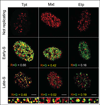DNA damage signaling assessed in individual cells in relation to the cell cycle phase and induction of apoptosis
- PMID: 23137030
- PMCID: PMC3522801
- DOI: 10.3109/10408363.2012.738808
DNA damage signaling assessed in individual cells in relation to the cell cycle phase and induction of apoptosis
Abstract
Reviewed are the phosphorylation events reporting activation of protein kinases and the key substrates critical for the DNA damage signaling (DDS). These DDS events are detected immunocytochemically using phospho-specific Abs; flow cytometry or image-assisted cytometry provide the means to quantitatively assess them on a cell by cell basis. The multiparameter analysis of the data is used to correlate these events with each other and relate to the cell cycle phase, DNA replication and induction of apoptosis. Expression of γH2AX as a possible marker of induction of DNA double strand breaks is the most widely studied event of DDS. Reviewed are applications of this multiparameter approach to investigate constitutive DDS reporting DNA damage by endogenous oxidants byproducts of oxidative phosphorylation. Also reviewed are its applications to detect and explore mechanisms of DDS induced by variety of exogenous agents targeting DNA such as exogenous oxidants, ionizing radiation, radiomimetic drugs, UV light, DNA topoisomerase I and II inhibitors, DNA crosslinking drugs and variety of environmental genotoxins. Analysis of DDS induced by these agents provides often a wealth of information about mechanism of induction and the type of DNA damage (lesion) and is reviewed in the context of cell cycle phase specificity, DNA replication, and induction of apoptosis or cell senescence. Critically assessed is interpretation of the data as to whether the observed DDS events report induction of a particular type of DNA lesion.
Figures








References
-
- Bakkenist CJ, Kastan MB. DNA damage activates ATM through intermolecular autophosphorylation and dimer dissociation. Nature. 2003;421:499–506. - PubMed
-
- Bakkenist CJ, Kastan MB. Initiating cellular stress responses. Cell. 2004;118:9–17. - PubMed
-
- Helt CE, Cliby WA, Keng PC, Bambara RA, O’Reilly MA. Ataxia telangiectasia mutated (ATM) and ATM and Rad3-related protein exhibit selective target specificities in response to different forms of DNA damage. J. Biol. Chem. 2005;280:1186–1192. - PubMed
-
- Kastan MB. DNA damage responses: Mechanisms and roles in human disease. 2007 G.H.A. Cloves Memorial Award Lecture. Mol Cancer Res. 2008;6:517–524. - PubMed
Publication types
MeSH terms
Grants and funding
LinkOut - more resources
Full Text Sources
Other Literature Sources
Research Materials
